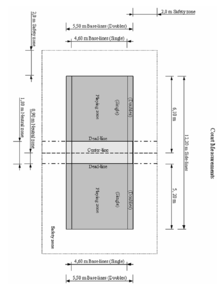Ring tennis
Ring tennis is a sport that is assigned to the return games . No bat is used.
The aim of the game is an approximately 210 to 230 g heavy foam rubber ring to throw (formerly rubber hollow rings) so that the enemy can not catch it. It is played in singles, doubles or mixed on a 12.20 m × 5.50 m field. (Single: 12.20 m × 3.70 m). In the middle of the field there is a 1.55 m high net. The ring must rise after leaving the thrower's hand and may rotate around its axis of symmetry, but not wobble or even overturn (error: from above, wobble ring - coll. Also referred to as "pretzel").
Catching, guiding and throwing the ring must be done in one fluid movement without stops or the like (error: stopped, two movements).
It is not allowed to run with the ring. With the ring in hand, only two touches of the ground are allowed. Each foot counts as a contact. Before the third contact, the ring must be thrown (error: steps). In the event of this mistake, the referee must count the mistake as a so-called "step mistake" and the opponent receives one point.
In Germany, ring tennis is organized as a gymnastics game in the German Gymnastics Federation . There is a year-round competition, the highlights of which are the German championships in summer and the German team championships in winter.
In addition to Germany, organized ring tennis (or Tenniquoits) can be found in South Africa , India , Brazil , Poland , Argentina , Bangladesh , Pakistan , New Zealand , Belarus , Kenya , Cameroon and Nepal . Ring tennis / Tenniquoits is also played in Australia, Mexico, Great Britain, Nigeria, Sri Lanka, Japan and Thailand.
The related ringo is played in Poland, the Czech Republic, Slovakia, Lithuania, Armenia, Belarus, Kenya and the USA.
From November 6th to 10th, 2006, the first ring tennis world championships took place in India. Since the national rules are different in the individual countries, there is a separate set of rules for international matches and the world championships. (e.g. single playing field: 12.20 m × 4.60 m; net height: 1.65 m). Germany was very successful at these world championships in Chennai (Madras), India . In addition to the individual competitions for women and men, women and men doubles were also won, whereby the doubles competitions only had the character of an exhibition fight and were also included in the program due to the large media presence. As a grand finale, the German team was finally able to secure the team title at the end of the 5-day event.
The second ring tennis world championships were held from July 31 to August 6, 2010 in Koblenz .
South Africa was the host of the third ring tennis world championships in 2014 . The title fights took place from March 30 to April 5, 2014 in Vereeniging in the province of Gauteng , where a total of six world titles were fought for. In addition to the women's and men's singles and the team competition - titles that all went to Germany - mixed, women's and men's doubles were official disciplines in the World Cup program for the first time. The member countries of the world association were allowed to send up to eight players in their delegations this time.
The venue for the fourth World Ring Tennis Championships in 2018 was Minsk in Belarus , and Germany became world champion in all disciplines.
Individual evidence
- ↑ "Members" menu item at http://www.tenniquoits.org/ , accessed on October 17, 2014
- ↑ World Championships , http://ringtennis.de/international/weltmeisterschaften/ , accessed on October 17, 2014
- ↑ Fourth World Ring Tennis Championships 2018 in Minsk (Belarus) , http://ringtennis.de/vierte-ringtennis-wm-2018-in-minsk-weissrussland/ , accessed on April 4, 2014.
- ↑ Germany takes all titles at the World Ring Tennis Championships. Retrieved January 19, 2020 .
Web links
- History, rules and tournament operations in Germany
- Website of the "World Tenniquoits Federation"
- Website of the "International Ringo Federation"
- Website of the "South African Tenniquoits Board"
- Website of the "US Ring Tennis Federation ™"
- Argentine ring tennis website
- World Cup 2014 South Africa - website with calendar and medal table for the World Cup from March 30th to April 5th, 2014


